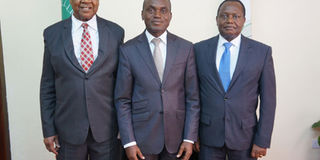Arusha-based African Court marks decade of human rights protection

From left: Justice Augustino Ramadhani of Tanzania, former president of the African Court on Human and Peoples’ Rights, incumbent president Justice Sylvain Ore of Cote d’Ivoire and vice-president Justice Ben Kioko of Kenya after court elections on September 5, 2016 in Arusha, Tanzania. PHOTO | COURTESY
What you need to know:
- The court was established by the African Union (AU) to complement the protective mandate of the African Commission on Human and Peoples’ Rights with a view to enhancing the enjoyment of human rights on the continent.
- The court's president, Justice Sylvain Ore, said since becoming operational in 2006, the institution had charted a "viable path" for the protection of human and peoples’ rights on the continent.
- One of the scheduled events is a commemorative symposium to educate citizens on the court's successes, weaknesses and challenges, and brainstorm on ways to ensure the court plays a meaningful role in protecting human rights in particular, and good governance as a whole.
The African Court on Human and Peoples’ Rights (AfCHPR) will mark 10 years since its inception next week for two days from November 21 in Arusha, Tanzania.
The court was established by the African Union (AU) to complement the protective mandate of the African Commission on Human and Peoples’ Rights with a view to enhancing the enjoyment of human rights on the continent.
The African Union Commission; High Representative of the Government of the United Republic of Tanzania; Coalition for an Effective African Court; Network of African NHRIs (NANHRI); and the Inter-American Court of Human Rights; and the European Court of Human Rights (ECtHR) are to issue statements during the fete.
The United Nations Office of the High Commissioner for Human Rights (OHCHR); African Committee of Experts on the Rights and Welfare of the Child; and the African Commission on Human and Peoples` Rights (ACHPR) are to also feature.
The court's president, Justice Sylvain Ore, said since becoming operational in 2006, the institution had charted a "viable path" for the protection of human and peoples’ rights on the continent.
“Within a decade of its operationalisation, the African Court has already brought about renewed hope and optimism within the African human rights system, and positioned itself as a veritable instrument in the quest for regional integration, peace, unity, good governance, respect for human rights and development,” he said.
ECONOMIC PROGRESS
Justice Ore said the jurisprudence of the African Court had reinforced the widely held view that respect for human rights provided a foundation upon which the political structures of human and peoples’ freedoms rest.
He explained that the achievement of human freedoms, in turn, generated the will as well as the capacity for economic and social progress, leading to the attainment of sustainable peace.
“There is therefore reason to be optimistic about the African Court’s role in the new African dispensation,” Justice Ore told the GNA.
The court's vice-president, Justice Ben Kioko, said the African Court that was established pursuant to the Protocol to the African Charter on Human and Peoples’ Rights had made tremendous achievement.
The court was adopted by member states of the then Organization of African Unity in Ouagadougou, Burkina Faso, on June 9, 1998.
The Protocol came into force on January 25, 2004, after it was ratified by more than 15 countries. However, the African Court became operational only in November 2006 when it officially started working in Addis Ababa, Ethiopia, and later moved to its current seat in Arusha, Tanzania.
Justice Kioko explained that although the Protocol was adopted in June 1998 by the then OAU, 17 years later, only 30 of the 54 African Union member states had ratified it.
“The even fewer number of declarations made in accordance with Article 34 (6) of the Protocol: Of these 30, only seven have made the declaration required under Article 34 (6) of the Protocol, which allows direct access to the Court for individuals and non-governmental organizations (NGOs),” Justice Kioko stated.
Rwanda withdrew from Article 34(6) in March this year.
ASSESS COURT’S WORK
One of the scheduled events is a commemorative symposium to educate citizens on the court's successes, weaknesses and challenges, and brainstorm on ways to ensure the court plays a meaningful role in protecting human rights in particular, and good governance as a whole.
The overall objective of the symposium is to assess the work of the court in the past 10 years with a view to making recommendations that will enhance its effectiveness for the future.
The symposium platform will be used to highlight the importance of the African Court in the AU architecture, reflect on the implementation of the decisions of the African Court, and assess its challenges, successes and prospects.
It will also examine the jurisprudence of the court, create avenues for sharing experiences from other regional and sub-regional human rights institutions concerning their judicial function during the early years of existence and garner opinions on how to enhance the court's legitimacy, access and effectiveness of its protective mandate.





